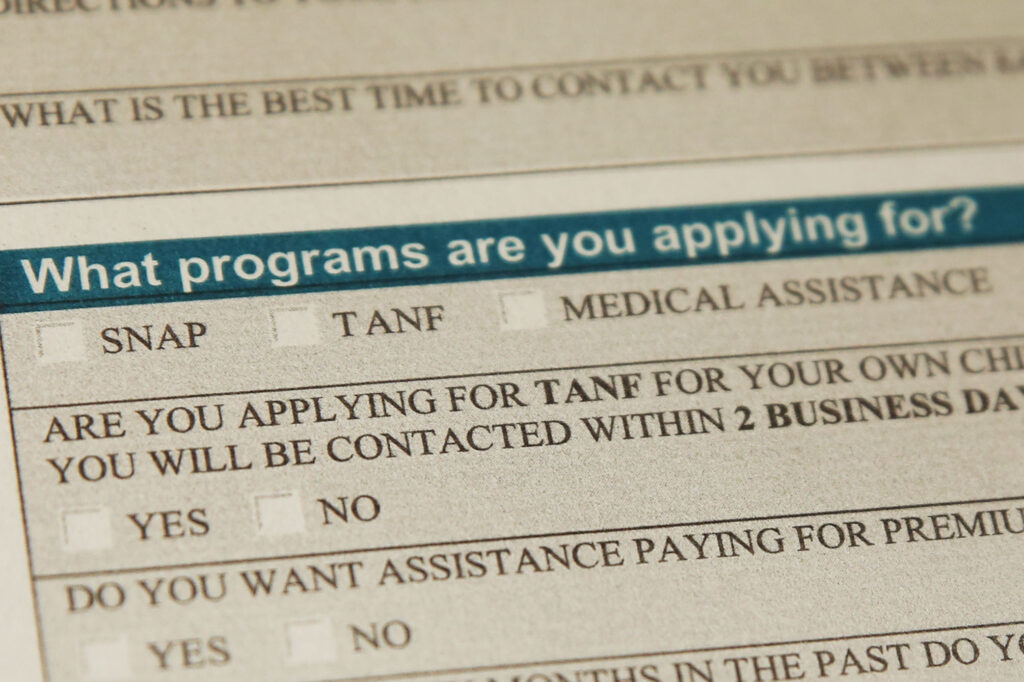
An application for economic assistance from programs managed by the South Dakota Department of Social Services. (Makenzie Huber/South Dakota Searchlight)
Starting in August, low-income South Dakota families participating in a welfare program will receive less money to spend on necessities such as gas, groceries, utilities and rent. The benefit cut is the beginning of more reductions planned in the next few years.
Lawmakers on the legislative Rules Review Committee voted 4-2 on Tuesday in Pierre to support the state Department of Social Services’ plan to reduce Temporary Assistance for Needy Families benefits by 10%. Recipients will lose anywhere from $32 to $136 a month in benefits, depending on the size of their family. The average household will lose $51 a month.
The state will save about $1.5 million annually. It distributed $15.3 million in TANF benefits last fiscal year.
TANF is a federal-state program most commonly used to provide financial assistance to low-income families with children, on the condition that the caregiver searches or trains for a job.
When lawmakers act, be in the know: Sign up for our free newsletter.
The two Democrats on the committee, Rep. Erik Muckey and Sen. Liz Larson, both from Sioux Falls, voted against the cut. They argued lawmakers were not aware of the reduction in benefits when they prepared the state’s budget earlier this year, and that the plan was a misrepresentation of legislative intent. Muckey said he and other legislators on the budget committee believed the $5.3 million state funding cut would be replaced with unspent TANF funds from previous years.
Instead, the department’s plan is to use $3.8 million of unused TANF funds and the 10% benefit reduction to cover the $5.3 million cut. The department plans to gradually reduce benefits each year, said Department Secretary Matt Althoff, cushioned by some unused TANF funds, until South Dakota reduces benefits to the minimum state contribution needed to receive federal funding.

“A 35% reduction all at once is a lot more devastating to a household than is the 10% on a strategic glide or slope,” Althoff said.
Gradual cuts until the state reaches a 35% reduction add up to the average household eventually losing $180 a month in benefits.
Republicans on the committee approved the plan, saying it was up to the department how to deal with the reduction in state funds.
“In appropriations we do not get down into the most minutia of running programs,” said Sen. Taffy Howard, R-Rapid City. “We have to leave those to the agencies to a certain degree.”
Althoff told lawmakers many TANF recipients receive other support: 99% of TANF households are enrolled in Medicaid, 97% receive Supplemental Nutrition Assistance Program funds, 57% live in subsidized housing and 15% are enrolled in the state Child Care Assistance program.
“TANF is not something that makes households whole,” Althoff said.

Two people spoke against the benefit cut Tuesday, including Cathy Brechtelsbauer. She opposed the proposal during its earlier public hearing in Sioux Falls as well.
“We don’t go through the whole budget process during the state Legislature and then show up in the summer and say, ‘Oh, we want to cut money and take it from children,’” Brechtelsbauer said.
The rule change also removes TANF eligibility for families who take in child relatives in situations when they’re removed from their homes by the state’s child welfare system.
That change incentivizes caregivers to become licensed kinship caregivers with the state, Althoff said during an earlier public hearing. The current foster and kinship subsidy rate for a child in South Dakota is between $22.85 and $27.43 a day, depending on their age. That would be roughly $685.50 to $822.90 a month, per child.
Lawmakers approved rule changes in May to create the licensed kinship foster care pathway, as required by the federal government. Caregivers must meet training requirements to become a licensed kinship home, similar though less intensive than traditional foster care requirements. There are no such requirements for TANF money.
According to the department, 184 cases per month managed by the department involving families eligible for TANF could be eligible for kinship subsidies.
Families who take in kin and apply for TANF use the “side door” to receive state and federal support, Althoff said. Eliminating TANF eligibility encourages families to “come in through the front door.”


